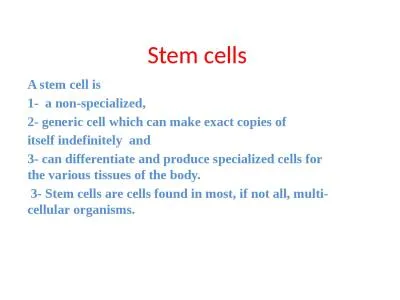

is 1 a nonspecialized 2 generic cell which can make exact copies of itself indefinitely and 3 can differentiate and produce specialized cells for the various tissues of the ID: 913807
Download Presentation The PPT/PDF document "Stem cells A stem cell" is the property of its rightful owner. Permission is granted to download and print the materials on this web site for personal, non-commercial use only, and to display it on your personal computer provided you do not modify the materials and that you retain all copyright notices contained in the materials. By downloading content from our website, you accept the terms of this agreement.
Slide1
Stem cells
A stem
cell
is
1-
a
non-specialized
,
2- generic
cell which can make exact copies of
itself
indefinitely and
3-
can differentiate and produce specialized cells for the
various tissues
of the
body.
3- Stem
cells are cells found in most, if not all,
multi-cellular organisms
.
Slide2Classification of stem cells on the basis of potency
Stem cells can be classified by the extent to which they can differentiate into
different cell types. These four main classifications are totipotent, pluripotent,multipotent, or unipotent. Totipotent The ability to differentiate into all possible cell types. Examples are thezygote formed at egg fertilization and the first few cells that result from the division of the zygote.
Slide3pluripotent
Pluripotent
The ability to differentiate into almost all cell types. Examples includeembryonic stem cells and cells that are derived from the mesoderm, endoderm ectoderm germ layers that are formed in the beginning stages of embryonic stem celldifferentiation.
Slide4Slide5Multipotent
and
MultipotentMultipotentThe ability to differentiate into a closely related family of cells. Examplesinclude hematopoietic (adult) stem cells that can become red and white blood cells orplatelets.OligopotentThe ability to differentiate into a few cells. Examples include (adult) lymphoid ormyeloid stem cells.
Slide6Slide7Unipotent
The ability to only produce cells of their own type, but have the property of
selfrenewal required to be labeled a stem cell. Examples include (adult) muscle stemcells.
Slide8Slide9Slide10Stem cells sources
Embryonic stem cells are derived from very early embryos and can in theory give rise to all cell types in the
body.Many adult tissues contain stem cells that can replace cells that die or restore tissue after injury. Skin, muscle, intestine and bone marrow, for example, each contain their own stem cells. In the bone marrow, billions of new blood cells are made every day from blood-forming stem cells
Slide11Potential uses of Stem cells